Mason Bees, and Mizuna, sums up a large part of my afternoon in the garden yesterday.
We first brought Mason Bees to the farm a couple of years ago.
This is their third year hatching in the garden here. For the first two seasons we mostly saw evidence of Mason Bees, rather than the bees themselves. We’d see the tubes hatched out in spring, and new tubes filled in by early summer, showing the bees were active.
As they’re somewhat shy, and elusive, compared to some of the other bees here, we’d very rarely notice them in the garden. Occasionally we’d see a glint of blue on a flower, but more often than not, it was merely a fly.[1]
As we only started with 2 tubes of bees (approximately 6 females and 6 males) it’s taken a while for them to build up much population here.
Last season we had 3 tubes hatch out, and by the end of the season we had 8 full tubes walled up ready for this spring.
So far this year it’s been a strange ‘spring’. We seemed to have more spring in January, which was quite warm and dry, compared to March which has been damp, no, downright wet, and occasionally cold.
The fruit trees bloomed early, and somewhat erratically, and it seems our Mason Bees hatched a little late, and erratically too.
Of those 8 tubes filled last season, so far only three have hatched. I expect something may have gone awry, but with our highly changeable weather, I’m giving the bees the benefit of the doubt before inspecting the unhatched tubes more closely.
Last week I actually helped a male Mason bee that had hatched behind a female pupa that wasn’t yet ready to emerge. If you read our last Mason Bee post, you know that usually the eggs destined to be males are laid closer to the entrance, as they hatch before the females.
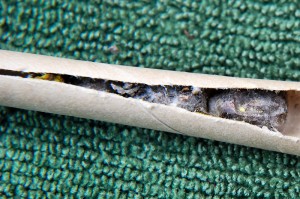
Each tube contains multiple cocooned bees, with males preferentially laid closer to the exit than the females
This was a tube of pupae that was accidentally mailed to us when we ordered a second Mason Bee habitat this winter. We suspect this habitat, along with the tube of bees, was used for demonstration purposes at a class, like the one we’d taken a few years ago, and the tube of cocooned bees was inadvertently left inside the container. We didn’t notice the tube of bonus bees for a few days, so we weren’t sure if they were still viable, but we placed the tube in the habitat just in case. when I checked the tube last week I found one poor upside down male, stuck, unable to exit the tube due to a rather rotund female pupa blocking the door.
I’m glad I checked, and was able to send him on his way.
Despite only three tubes (plus our partial bonus tube of bees) hatching so far this season, the Mason Bees have actually been much more noticeable in the garden this year. Perhaps this is because there are more bees, or maybe it’s because there are more blooms in the vegetable garden…courtesy of my lax gardening so far this spring.
The goats have helped us to drift off our gardening schedule, but I have succeeded in exercising some discipline recently, and do have trays, and trays, and trays of seedlings started. Everything is just a couple of weeks behind schedule. As such, the Komatsuna, Arugula, and especially the volunteer mighty Mizuna, are blooming up a storm at the moment, as I don’t feel compelled to pull them until I have transplants to replace them with.
I can’t complain, there’s not a lot blooming here at the moment, and honestly the Mizuna is putting on quite a show, both for us, and the bees!
I learned something yesterday too. Mizuna blossoms have an abolutely heavenly aroma, especially when they bloom as profusely as this ONE plant is!
As I was standing, ogling the hoards of pollinators on the flowers, I couldn’t figure out where the sweet perfume was coming from. I looked around, and only found a few scant native poppies blooming, along with some rosemary. Then, leaning in to take these photographs, I realized the fragrance was the Mizuna! Who knew?!
I have never noticed any bolted vegetable to have such a pleasing fragrance in the garden, and honestly, the mass of blooms at the moment is more spectacular than anything else in bloom in the vegetable garden. Perhaps it’s the perfume from these unassuming flowers that has been luring the Mason Bees too. Whatever it is, this plant was teaming with life yesterday, and finally gave me a chance to really watch these docile bees up close. Close enough to see the three dorsal ocelli, light-sensing organs, on the top of this male’s head.
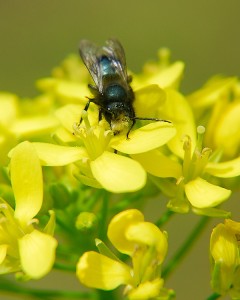
If you look closely, you can see the three ocelli (light sensing organs) on the top of this bee's head
We’ll keep watching to see if any of the remaining tubes hatch out in the next few weeks.
If not, we’ll post about our findings when we examine them more closely, and hope that this female at least is laying lots of healthy eggs.
Speaking of bees, we’re off to check the honeybees, especially the Rosemary hive that was split from the Salvia colony a month ago, and weather permitting, we’ll finally split Lavender this afternoon too! It’s all abuzz around here this week!
——————-
[1] For tips on telling the difference between bee and fly species in the garden, see The Great Sunflower Project’s ‘How to Tell a Bee‘ article.


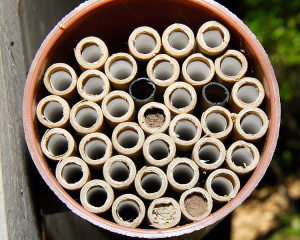
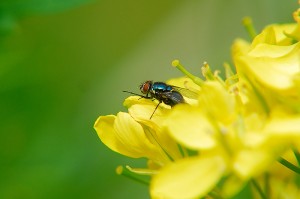
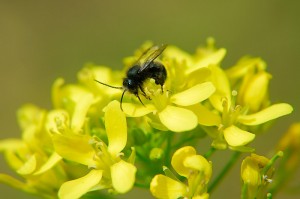
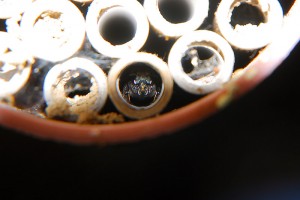
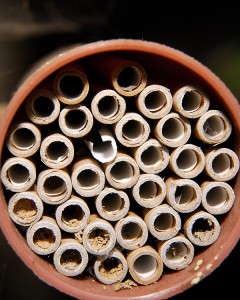
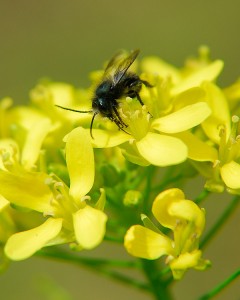
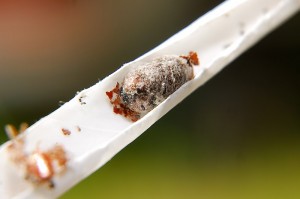
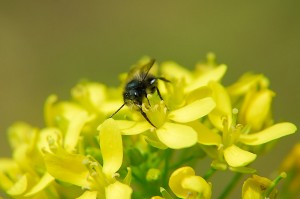
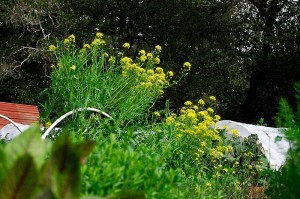
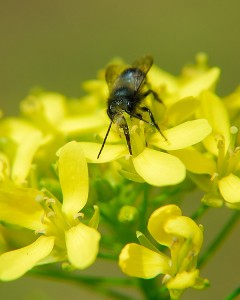
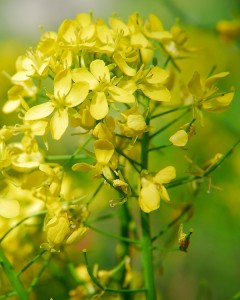
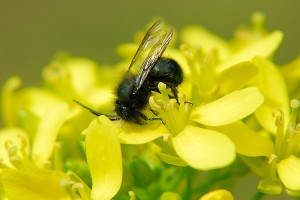
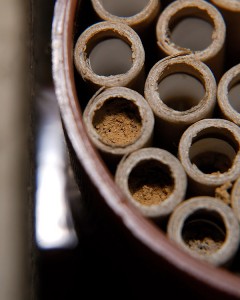
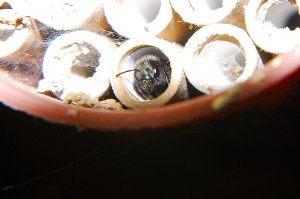







The Asian greens are wildly blooming here as well. I had a Maruba Santoh that bloomed in the greenhouse, and the scent almost reminded me of a narcissus it was so sweet. The honeybees loved it too. Now I have green and red mizuna blooming, and I can’t bring myself to pull them either!
I was really surprised how sweet these blooms were. I don’t usually expect your typical brassica bloom to have so much fragrance. I am very hesitant to pull them, especially as all the bees and syrphid flies are enjoying them at the moment…but this one was a volunteer, and if I wait too long the mighty Mizuna might just take over!!! 😛
Beautifully capture! Mizuna is my favorite 🙂
I thought Tatsoi was my favorite…but I think it’s been replaced. These Mizuna greens grew all through winter, through frost, soaking rains, and always looked, and performed, spectacularly well in the winter garden.
Perfect timing to learn about these bees since I will be installing a mason bee house…great to know these things and what to look for…
You’ll enjoy your new Mason Bee habitat Donna. In fact, wait a couple of years, and I expect you’ll add at least one more 😉
Clare, everyone should enlarge your images because they are wonderful closeups. Thanks for the pdf link for telling bees from flies. I never realized what these mason bees looked like. The do resemble a fly a bit.
The bees do have that glint of blue as they zip between the flowers, and as they don’t sit still very long, it can be very difficult to tell a Mason Bee from a fly sometimes. I like the PDF, as it outlines some basic cues for identifying bees, like antennae length, number of wings, and wing position etc. It’s amazing when you just sit and stare at a flower cluster like this, just how many different species of pollinators you can see 🙂
They really do look like flies until you click on the photos to enlarge and see that they are quite hairy. Wonderful detail in the macros Clare………..do you use a tripod to get those or just hand held with an IS lens? I think I should grow some Mizuna just to experience that scent! the leaves certainly would add some textural interest to the border alone.
Thanks Rosie, actually, I’m too lazy to use a tripod. They’re cumbersome and awkward to lug around our slopes here. I really should get a monopod though, because sometimes it’s almost impossible to freehand shots like this. I usually have to hold my breath during a shot, and not drink too much coffee that day 😛
I’ve ‘missed’ a lot of shots though because I’m not good about using a tripod, but honestly, when shooting fast moving bees, you really have to be able to move with the bee, which would be almost impossible with a tripod I would think (a monopod would grant more freedom of movement, and still provide some stabilization), unless you focus on a flower, and wait for the bee to come to you.
I just used an 18-70mm lens with a 4x macro filter. Shutter priority is a must though, or they all come out a blur!
what a joy to read, as always Clare. The bee images are wonderful. Had to look up Mizuna and like the flowers suggest they are mustards – no wonder they smell so alluring. Horseradish flowers are as sweet too.
I never smelled a horseradish bloom either. I think my problem is I was always one of “those gardeners” who wouldn’t dream of letting my veggies bloom. When they were done, they were pulled. Clearly I was missing out…and so were the bees! 😉
I see different types of bees (and flies) all over the blooms in my garden, but I have no idea which types of bees they are. I appreciate learning about the different bees from you.
I have fun stalking the pollinators with my camera. Even if I don’t know who I’m shooting, if I can get a clear enough shot, it’s fun sometimes trying to figure out who is who among the flowers. At the moment we have a lot of Syrphid (Flower) Flies in the vegetable garden, many different species, and I’m happy to see them because their larvae eat aphids!!! That’s worth letting a Mizuna bloom just to encourage more aphid eating creatures in the garden!
I looked into getting mason bees last year, but then I read all this stuff about having to collect the cocoons and store them in the fridge at the right humidity until the following spring and suddenly it seemed overwhelming. Do you just leave your habitat out, or do you put them away? I am inspired again. So beautiful! And I like the idea of supporting native bees in addition to our honey bees.
We simply leave our bees out all season. They’re adapted to much colder climates than ours, and survive fine in the wild. I think it’s more important to orient the habitat toward morning sun (east to southeast), and to be sure the habitat has some protection from driving rain. We mount our habitats with a very slight pitch down toward the entrance. Not so much the tubes slide out, but any driving rain that might get in will drain back out. Ours are also mounted under the eaves of the workshop for a little extra protection. Alternatively, you can build or buy a little box with an overhang to protect them. All that said, we’re in USDA Zone 9, and our winters are quite mild. This is the first season we’ve noted late hatching, but our weather has been a bit odd this year, so they may not be done yet. Overall, they’re phenomenally easy bees to have in your gardens, and I’d definitely say give it go!
Excellent. I’ll gve it a try. Thanks!
Hope there’s nothing wrong with the tubes and it’s just the wacky weather. I’ve never seen or smelled Mizuna. Sounds like a feast for the bees! Thanks for your blueberry tips and comments. 🙂 I hope we get a decent harvest this year.
I hope the bees are alright too, but it’s not looking too promising. I’m not sure what could have happened, but now I’m curious to inspect one.
I have often thought about adding these nests for the Mason bees. One of my friends has added these nests throughout her garden. It is nice to read more about these pollinators…thanks for the tips!
The nice thing with Mason Bees, is once the habitats are installed, the bees basically take care of themselves. They don’t produce honey, but they’re excellent pollinators, and not nearly as much work as our honey bees! 😉
I am amazed that you now add bee midwife to your resume! All of your photos are wonderful. My broccoli and collard greens have all bolted, and the yellow flowers are so lovely I can’t bring myself to pull them. Little bees have been enjoying them, but I don’t know what kind they are.
‘Bee Midwife’, I hadn’t thought of it that way 🙂 I was glad I able to help the little fellow exit into the world. Last I looked, that giant female cocoon still hadn’t hatched, so I expect she’s unlikely to at this point. I have to assume the cocoons got reordered during a demonstration. He should have been positioned much closer to the door. Who knows, perhaps the male on the Mizuna blooms was him?
Very interesting all about the mason bees. I am glad you take such an in depth interest in wildlife because I get to learn along with you.
I love living here. Plenty of room to garden, and surrounded by nature, about which I’ve had an endless curiosity my entire life. It’s fun getting to know all the creatures here 🙂
Fragrance, mizuna? Who knew. Next time I’ll let it bolt. I’d say you are about a month ahead of us here in the Puget Sound area as I won’t be seeing mason orchard bees here for at least another three weeks.